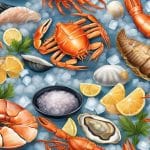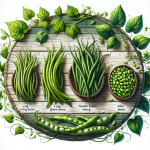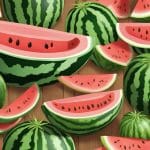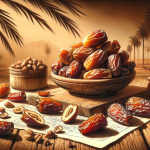Types Of Salmon
Salmon is a popular type of seafood that is enjoyed by people around the world. It is not only delicious, but it is also packed with nutrients, including protein and omega-3 fatty acids. However, not all salmon is created equal. There are different types of salmon, each with its own unique characteristics and flavor profiles.
One way to categorize salmon is by its origin. Pacific salmon, for example, includes six different species: Chinook, Coho, Sockeye, Pink, Chum, and Steelhead. Atlantic salmon, on the other hand, is only one species. Each type of salmon has its own distinct flavor and texture, making it important to choose the right one for your recipe.
Understanding the different types of salmon can help you make informed choices when it comes to buying and cooking this delicious seafood. In this article, we will explore the various types of salmon, their characteristics, and their place in the ecosystem.
Key Takeaways
- There are different types of salmon, including Pacific and Atlantic salmon, each with its own unique characteristics and flavor profiles.
- Salmon is a nutritious food that is high in protein and omega-3 fatty acids.
- Conservation and sustainability are important considerations when it comes to choosing and consuming salmon.
Types of Pacific Salmon
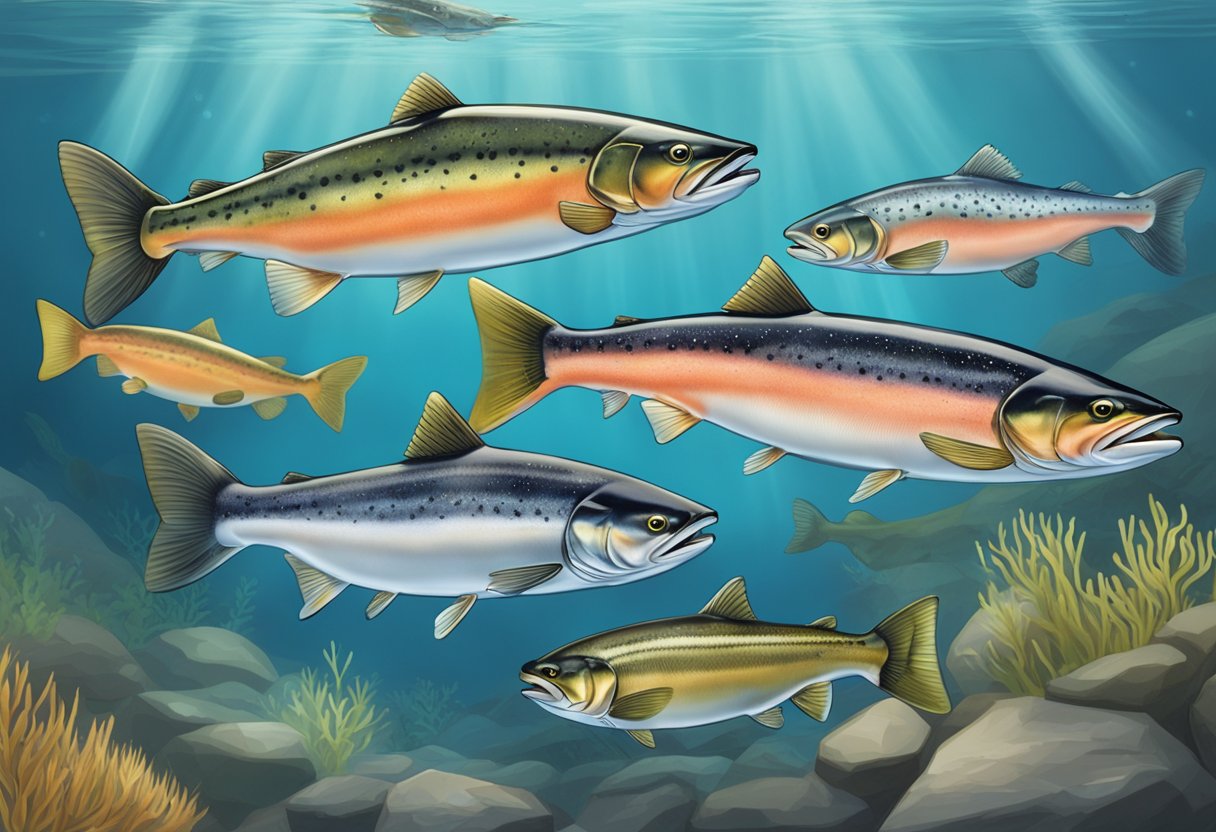
Pacific salmon, also known as Oncorhynchus, are a group of fish species found in the Pacific Ocean and its tributaries. There are five main types of Pacific salmon, each with its unique characteristics and flavor profile. Here are the different types of Pacific salmon:
King Salmon (Chinook)
King salmon, also known as Chinook salmon, is the largest and most prized of all Pacific salmon species. They are known for their rich, buttery flavor and firm texture. King salmon can weigh up to 135 pounds and are typically found in the waters of Alaska, Canada, and the Pacific Northwest. They have a high oil content, making them perfect for grilling, smoking, or baking.
Sockeye Salmon (Red Salmon)
Sockeye salmon, also known as red salmon, is known for its deep red flesh and bold flavor. They are typically found in the waters of Alaska and the Pacific Northwest. Sockeye salmon has a firm texture and a slightly lower oil content than King salmon, making it perfect for grilling or broiling.
Coho Salmon (Silver Salmon)
Coho salmon, also known as silver salmon, is a medium-sized Pacific salmon species. They have a milder flavor than King and Sockeye salmon and a softer texture. Coho salmon is typically found in the waters of Alaska and the Pacific Northwest. They are perfect for baking or smoking.
Pink Salmon (Humpback Salmon)
Pink salmon, also known as humpback salmon, is the smallest and most abundant of all Pacific salmon species. They are typically found in the waters of Alaska and the Pacific Northwest. Pink salmon has a mild flavor and a soft texture, making them perfect for canning or smoking.
Chum Salmon (Dog Salmon)
Chum salmon, also known as dog salmon, is the least prized of all Pacific salmon species. They are typically found in the waters of Alaska and the Pacific Northwest. Chum salmon has a mild flavor and a firm texture, making them perfect for smoking or grilling.
In conclusion, Pacific salmon is a group of fish species found in the Pacific Ocean and its tributaries. The five main types of Pacific salmon are King salmon, Sockeye salmon, Coho salmon, Pink salmon, and Chum salmon. Each type of Pacific salmon has its unique characteristics and flavor profile.
Atlantic Salmon
Atlantic salmon (Salmo salar) is a species of fish that is native to the North Atlantic Ocean. They are anadromous, meaning that they spend most of their lives in the ocean, but return to freshwater rivers and streams to spawn.
Unfortunately, Atlantic salmon populations have been declining for decades due to overfishing, habitat destruction, and pollution. As a result, they are now considered an endangered species in many parts of their range.
In recent years, the demand for Atlantic salmon has led to the development of salmon farming, which has been controversial due to concerns about the environmental impact and the welfare of the fish. Farmed Atlantic salmon are typically raised in net pens in the ocean, where they are fed a diet of fishmeal and fish oil.
While farmed Atlantic salmon is more widely available and less expensive than wild-caught Atlantic salmon, many people prefer the taste and nutritional benefits of wild-caught fish. Wild-caught Atlantic salmon is typically more flavorful and has a firmer texture than farmed salmon. It is also higher in omega-3 fatty acids, which are essential for good health.
In conclusion, Atlantic salmon is a delicious and nutritious fish that is unfortunately endangered in many parts of its range. While farmed Atlantic salmon is more widely available, many people prefer the taste and nutritional benefits of wild-caught fish.
Salmon Characteristics
Salmon is a popular fish that is known for its unique flavor, texture, and nutritional benefits. In this section, we will explore the physical features, flavor and texture, and nutritional profile of salmon.
Physical Features
Salmon is a medium to large-sized fish that can range in length from 20 to 30 inches. The size of the fish can vary depending on the species and the environment in which it lives. Salmon has a distinctive silver skin and bright red flesh that is rich in color. This is due to the presence of astaxanthin, a carotenoid pigment that is naturally found in the fish’s diet.
Flavor and Texture
Salmon has a rich, buttery flavor that is often described as mild and slightly sweet. The texture of the fish is firm and meaty, with a delicate flake that is easy to eat. The flavor and texture of salmon can vary depending on the species, the environment in which it lives, and the diet of the fish.
Nutritional Profile
Salmon is a nutrient-dense fish that is high in protein, omega-3 fatty acids, and essential minerals. Omega-3 fatty acids are essential fats that are important for brain health, heart health, and overall well-being. Salmon is also a good source of vitamin D, vitamin B12, and selenium.
Here is a table that summarizes the nutritional profile of salmon:
| Nutrient | Amount per 3.5 ounces (100 grams) |
|---|---|
| Calories | 206 |
| Protein | 22 grams |
| Fat | 13 grams |
| Omega-3 fatty acids | 2.3 grams |
| Vitamin D | 17% of the Daily Value (DV) |
| Vitamin B12 | 51% of the DV |
| Selenium | 52% of the DV |
In conclusion, salmon is a delicious and nutritious fish that is enjoyed by many people around the world. Its unique flavor, texture, and nutritional benefits make it a popular choice for seafood lovers everywhere.
Salmon in the Ecosystem
Salmon are an important species in the ecosystem, playing a vital role in the food chain and nutrient cycling. They are known as a keystone species, which means that they have a disproportionate impact on their environment relative to their abundance.
Life Cycle and Reproduction
Salmon have a unique life cycle that involves spawning in freshwater rivers, migrating to the ocean to feed and grow, and returning to their natal streams to spawn and die. The spawning process is a critical component of the salmon life cycle, as it allows for the continuation of the species.
During the spawning process, female salmon lay their eggs in nests, or redds, in the gravel at the bottom of rivers. Male salmon then fertilize the eggs, and the eggs hatch into alevins, which eventually grow into fry. The fry then migrate downstream to the ocean, where they spend several years feeding and growing before returning to their natal streams to spawn.
Habitat and Distribution
Salmon are found in a variety of habitats, including freshwater lakes and rivers, as well as the Pacific Ocean. They are most commonly associated with freshwater rivers, where they spawn and hatch, but they spend the majority of their adult lives in the ocean.
Salmon populations are distributed throughout the Pacific Northwest, including Alaska, British Columbia, Washington, Oregon, California, and parts of Asia. The specific habitats and distribution of salmon populations vary depending on the species, as well as other environmental factors such as water temperature and availability of food.
Overall, salmon play a critical role in the ecosystem, both as a food source for other species and as a key player in nutrient cycling. Understanding the life cycle and habitat of salmon is essential for managing and conserving these important species.
Conservation and Sustainability
Salmon is a popular fish that is consumed all over the world. However, the increasing demand for salmon has led to overfishing and depletion of wild salmon populations. To address this issue, conservation and sustainability practices have been implemented to ensure the long-term survival of salmon.
One of the main concerns with salmon is the impact of aquaculture on the environment. Farmed salmon is often criticized for its negative environmental impact, such as the release of contaminants and waste into the surrounding waters. However, sustainable aquaculture practices can minimize the negative impact of salmon farming on the environment.
To ensure the sustainability of salmon, organizations such as Seafood Watch and Marine Stewardship Council have developed guidelines for sustainable fishing practices. These guidelines take into account the health of wild salmon populations and the impact of fishing on the environment.
Salmon is also an endangered species in some regions, such as the Atlantic salmon in the Gulf of Maine. Conservation efforts are being made to protect these populations and prevent further decline.
Consumers can also play a role in the conservation and sustainability of salmon by choosing to purchase sustainably sourced salmon. This can be done by looking for certification labels from organizations such as the Marine Stewardship Council.
Overall, conservation and sustainability practices are crucial for the long-term survival of salmon. By implementing these practices, we can ensure that future generations will be able to enjoy this delicious fish.


